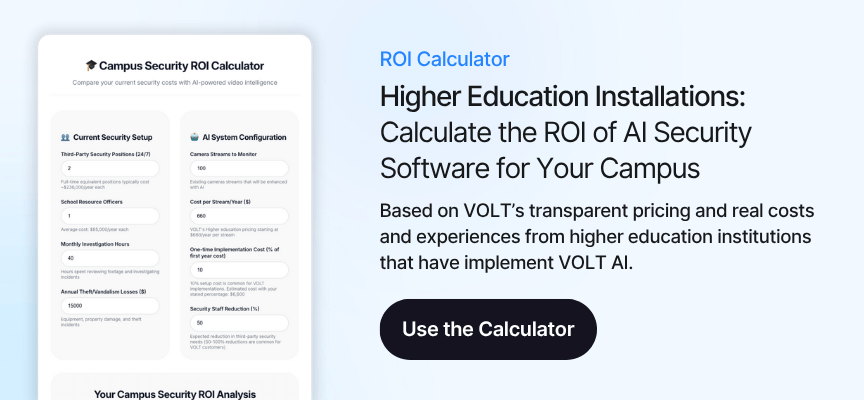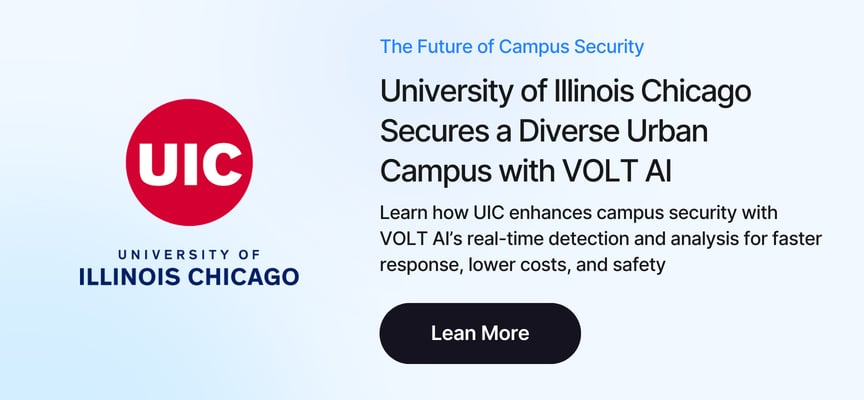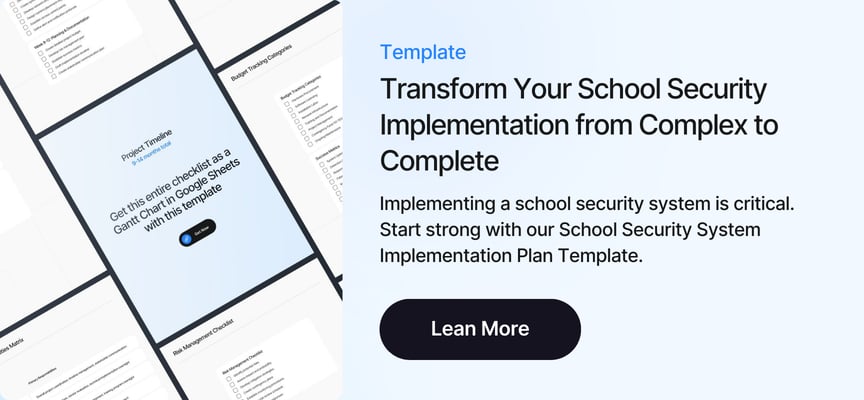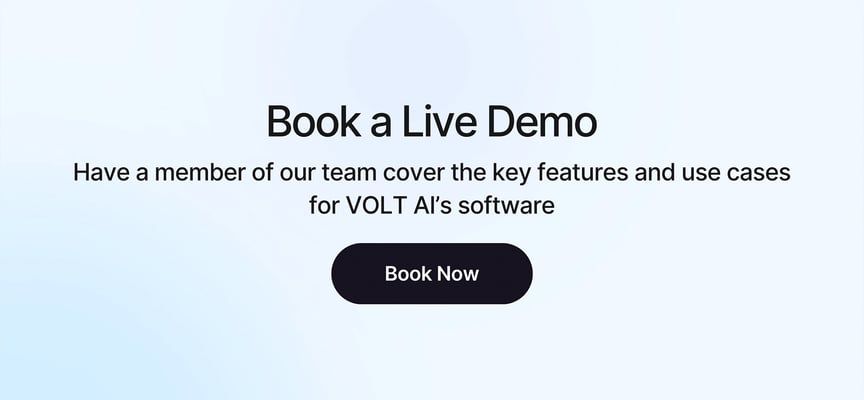Key Points
- Human verification eliminates alert fatigue: VOLT's 24/7 Security Operations Center validates every AI detection before escalating to campus security operations teams
- Real-time response without false positives: AI detects potential threats in seconds while human operators confirm legitimacy before alerts reach campus security operations
- Cost-effective force multiplication: Transform existing camera infrastructure into intelligent monitoring without adding security personnel to campus security operations
- Proven campus deployment success: Universities like UIC and Maryville have significantly reduced third-party security costs while improving campus security operations response times
- Privacy-compliant tracking: Advanced behavioral analysis without facial recognition meets state privacy requirements while maintaining campus security operations effectiveness
The False Positive Problem Plaguing Campus Security Operations
Campus security operations face a critical challenge that threatens the effectiveness of modern safety systems across higher education institutions. Alert fatigue has become the silent enemy of security teams nationwide, fundamentally undermining campus security operations effectiveness. Traditional security systems generate so many false alarms that security personnel often become desensitized to alerts, creating dangerous gaps in response protocols.
The problem stems from purely automated systems that lack contextual understanding in campus security operations. Motion detectors trigger on maintenance staff. Analytics software flags routine activities as suspicious behavior. Weather conditions create phantom threats that demand investigation from campus security operations teams.
Learn from real campus safety leaders that have implemented AI solutions.
The Hidden Cost of Alert Fatigue in Campus Security Operations
These systems generate alerts without discrimination, overwhelming security teams with noise instead of actionable intelligence for campus security operations. This alert fatigue phenomenon has real consequences for modern campus safety. When every system cries wolf, security professionals develop response patterns that prioritize obvious threats while potentially overlooking genuine emergencies in campus security operations.
The result is a security posture that appears comprehensive on paper but fails to deliver when it matters most for campus security operations. Security teams waste valuable time investigating false alarms while genuine threats may receive delayed or inadequate response, compromising the overall effectiveness of campus security operations.
The Human + AI Advantage in Modern Campus Security Operations
VOLT's approach addresses the fundamental flaw in purely automated security systems through human-verified AI detection for campus security operations. This hybrid model combines the speed and consistency of artificial intelligence with the contextual judgment that only human operators can provide. The result transforms campus security operations from reactive investigation to proactive threat prevention.
The Three-Tier Verification Process for Campus Security Operations
The system operates through a sophisticated three-tier process designed specifically for campus security operations. AI security cameras continuously monitor camera feeds, identifying potential threats with remarkable speed and accuracy. When the system detects something noteworthy, trained security professionals in VOLT's 24/7 Security Operations Center immediately review the footage.
Only verified incidents escalate to campus security operations teams, ensuring every alert demands genuine attention. This verification process eliminates the noise that plagues traditional systems in campus security operations. Campus security personnel receive alerts they can trust, knowing that human intelligence has already confirmed the legitimacy of each incident.
Psychological Impact on Campus Security Operations Teams
The psychological impact cannot be overstated for campus security operations effectiveness. Security teams respond with appropriate urgency because they know VOLT alerts represent real situations requiring immediate attention. This trust relationship between technology and personnel creates a more effective security culture where alerts receive proper prioritization and response in campus security operations.
Calculate the ROI of AI Security Software for Your Campus.
Technical Architecture: How Human Verification Works in Campus Security Operations
VOLT's Security Operations Center operates as the critical junction between AI detection and campus response in modern campus security operations. The facility maintains 24/7 staffing with trained security professionals who understand both technology capabilities and real-world security scenarios for campus security operations. These operators serve as the intelligent filter that transforms raw AI detections into actionable security intelligence.
Detection and Verification Workflow for Campus Security Operations
The verification process begins the moment AI algorithms identify potential threats in campus security operations. Operators receive immediate notifications with video footage, location data, and contextual information about the detection. They analyze multiple camera angles, review preceding events, and apply human judgment to determine threat legitimacy for campus security operations.
This entire process typically completes within seconds of initial detection for campus security operations. The sophistication of this verification extends beyond simple yes-or-no decisions. Operators provide contextual notes that help campus security operations teams understand the nature of detected threats.
AI Detection Capabilities Comparison for Campus Security Operations
Detection Type | Pure AI Systems | Human + AI (VOLT) | Traditional Campus Security Operations |
Weapon Detection: Firearms, knives | High accuracy, many false positives | High accuracy, verified alerts only | Reactive, post-incident only |
Person Down: Medical emergencies | Moderate accuracy, weather/shadow issues | High accuracy, context-aware verification | Relies on witness reports |
Unusual Behavior: Loitering, trespassing | Low accuracy, many routine activities flagged | High accuracy, human context applied | Manual observation only |
Fight Detection: Physical altercations | Moderate accuracy, sports/play confusion | High accuracy, verified incidents only | Witness-dependent reporting |
Crowd Analysis: Unusual gatherings | Basic counting, no context | Intelligent assessment with human judgment | Visual estimation only |
Integration Capabilities for Campus Security Operations
VOLT's human + AI system integrates seamlessly with existing campus security operations without disrupting established protocols. The technology works with current camera infrastructure, eliminating the need for expensive hardware replacements in campus security operations. Campus security teams continue using familiar communication channels while benefiting from dramatically improved alert quality.
The system's flexibility allows customization for each campus's unique needs in campus security operations. Security teams can establish specific escalation protocols, determine which incidents require automatic law enforcement notification, and create custom alert categories that align with their operational procedures.
Real-World Campus Security Operations Implementations
University of Illinois Chicago: Large Urban Campus Security Operations Success
The University of Illinois Chicago demonstrates the power of human-verified AI in campus security operations. Before implementing VOLT, UIC struggled with third-party security personnel sleeping on duty and inconsistent coverage across their 250-acre urban campus. The university was spending approximately $2-3 million annually on third-party security contracts that delivered unreliable results to their campus security operations.
VOLT's human + AI approach transformed UIC's campus security operations dramatically. The system successfully identified genuine threats, including an individual carrying a concealed weapon in challenging detection conditions. The dark-handled weapon against dark clothing would have been nearly impossible for human observers to spot, yet AI detection coupled with human verification enabled rapid response and successful intervention in their campus security operations.
Maryville University: Private Campus Security Operations Excellence
Maryville University's implementation showcases the effectiveness of human + AI systems on smaller campus environments. The university transformed their security operations by implementing VOLT across 400 of their 633 cameras, focusing on high-priority areas including dormitories, athletic facilities, and main campus entrances.
The results exceeded expectations for their campus security operations. The system detected a fight incident and provided alerts within 21 seconds of the altercation beginning. More importantly, the human verification component prevented false alarms while ensuring genuine incidents received immediate attention in their campus security operations.
Key Implementation Benefits for Campus Security Operations
- Third-party security reduction: UIC reduced third-party security contracts by approximately 50% while improving coverage quality in campus security operations
- Response time improvement: Verified alerts enable immediate deployment without investigation delays in campus security operations
- Cost savings realization: Elimination of false alarm responses frees security personnel for genuine threats in campus security operations
- Enhanced investigation capabilities: Real-time tracking and automated reporting streamline incident management for campus security operations
- Improved staff satisfaction: Security teams report higher job satisfaction when alert systems prove reliable in campus security operations
Addressing Privacy Concerns in Campus Security Operations
Privacy considerations play a crucial role in campus security operations, particularly in states with strict biometric data regulations. VOLT's approach addresses these concerns through behavioral analysis rather than facial recognition technology. The system tracks individuals based on movement patterns, clothing descriptions, and behavioral characteristics without storing or processing biometric identifiers in campus security operations.
Privacy-Compliant Tracking Methods for Campus Security Operations
This privacy-conscious approach satisfies regulatory requirements while maintaining security effectiveness for campus security operations. Campus administrators can implement comprehensive monitoring without violating student privacy rights or triggering compliance issues. The technology focuses on actions and behaviors rather than personal identification, creating a security solution that respects individual privacy while protecting community safety in campus security operations.
The human verification component adds another layer of privacy protection for campus security operations. Trained operators apply judgment about what information requires escalation, ensuring campus security teams receive relevant threat intelligence without unnecessary exposure to routine campus activities.
Regulatory Compliance Standards for Campus Security Operations
VOLT maintains SOC 2 Type II compliance and adheres to data encryption standards for both data in transit and at rest. These architectural privacy and compliance standards enable deployment across diverse regulatory environments without compromising security effectiveness or institutional compliance requirements for campus security operations.
Read our Complete Guide to AI-Powered Campus Security Systems.
Cost Analysis: Human + AI vs. Traditional Campus Security Operations Approaches
Campus security operations face constant pressure to balance safety requirements with budget constraints. Traditional approaches often involve expensive trade-offs between comprehensive coverage and cost control. VOLT's human + AI model presents a compelling alternative that delivers superior results at reduced long-term costs for campus security operations. For institutions looking to evaluate their security investments, understanding the complete ROI picture becomes essential.
Comprehensive Cost Comparison for Campus Security Operations
Security Approach | Initial Investment | Annual Operating Cost | Coverage Quality | False Positive Rate | Response Effectiveness |
Third-Party Security | Low | $200K-$3M per year | Inconsistent | High | Variable |
Pure AI Systems | Moderate | $50K-$200K per year | Limited context | Very High | Poor due to false alarms |
VOLT Human + AI | Moderate | $50K-$300K per year | Comprehensive | Minimal | High reliability |
Traditional Monitoring | Low | $100K-$500K per year | Limited hours | N/A | Reactive only |
Hidden Costs of False Positives in Campus Security Operations
The cost comparison reveals significant advantages for human-verified AI systems in campus security operations. While pure AI solutions appear less expensive initially, their high false positive rates create hidden costs through wasted security personnel time and reduced response effectiveness. Third-party security services provide human judgment but lack the consistency and coverage that AI monitoring delivers for campus security operations.
ROI Calculation Factors for Campus Security Operations
- Personnel optimization: Reduce third-party security contracts while maintaining superior coverage in campus security operations
- Response efficiency: Eliminate wasted time investigating false alarms in campus security operations
- Liability reduction: Faster response to genuine threats reduces institutional exposure for campus security operations
- Insurance benefits: Comprehensive monitoring may qualify for premium reductions affecting campus security operations budgets
- Operational savings: Automated reporting and investigation tools reduce administrative overhead in campus security operations
Implementation Strategies for Campus Security Operations
Successful implementation of human + AI systems requires careful planning and phased deployment for campus security operations. Campus security operations benefit from starting with pilot programs that demonstrate value before full-scale rollouts. This approach allows security teams to understand system capabilities while building confidence among stakeholders. For institutions ready to move forward, having a comprehensive implementation plan streamlines the deployment process.
Pilot Program Best Practices for Campus Security Operations
The pilot phase should focus on high-value areas where security challenges are most pronounced in campus security operations. Common starting points include main entrances, parking areas, student life facilities, and locations with previous security incidents. These areas provide clear success metrics while offering immediate value to campus security operations.
Technical Requirements Assessment for Campus Security Operations
Infrastructure Component | Minimum Requirements | Recommended Specifications | Notes for Campus Security Operations |
Network Bandwidth | 2 Mbps per camera | 5 Mbps per camera | Higher bandwidth improves AI processing speed |
Camera Resolution | 1080p minimum | 4K preferred | Better resolution enhances detection accuracy |
Storage Capacity | 30 days retention | 90 days retention | Longer retention supports investigations |
Network Latency | <100ms to VOLT SOC | <50ms preferred | Lower latency improves verification speed |
Power Infrastructure | Standard PoE+ | PoE++ for advanced cameras | Ensures reliable camera operation |
Deployment Phase Planning for Campus Security Operations
- Phase 1 assessment: Network infrastructure evaluation and camera compatibility testing for campus security operations
- Phase 2 pilot: Deploy 20-30 cameras in high-priority areas for initial validation of campus security operations
- Phase 3 expansion: Scale to full deployment based on pilot results and stakeholder feedback for campus security operations
- Phase 4 optimization: Fine-tune detection parameters and escalation protocols for campus security operations
- Phase 5 maintenance: Establish ongoing monitoring and system optimization procedures for campus security operations
Staff Training and Change Management for Campus Security Operations
Effective deployment requires collaboration between technology providers, campus security operations teams, and IT departments. The integration process should minimize disruption to existing operations while maximizing system effectiveness. Key considerations include network infrastructure, camera compatibility, and staff training requirements for campus security operations. For institutions working with limited security teams, proper training becomes even more critical to maximizing the force multiplication effect.
Security Team Preparation for Campus Security Operations
- System operation training: Educate security personnel on new alert protocols and response procedures for campus security operations
- Technology familiarization: Provide hands-on experience with VOLT portal and mobile applications for campus security operations
- Escalation protocol establishment: Define clear procedures for different alert types and severity levels in campus security operations
- Communication workflow optimization: Integrate VOLT alerts with existing dispatch and response systems for campus security operations
- Performance metrics understanding: Train supervisors on system analytics and effectiveness measurement for campus security operations
Stakeholder Communication Strategy for Campus Security Operations
Campus administrators require comprehensive understanding of privacy protections, operational benefits, and cost implications for campus security operations. Effective communication addresses concerns proactively while highlighting measurable improvements in security effectiveness and operational efficiency. Budget planning tools help administrators understand the complete financial picture.
Performance Measurement and Optimization for Campus Security Operations
Quantifying the effectiveness of human + AI systems requires comprehensive metrics that capture both security outcomes and operational efficiency for campus security operations. Traditional security measurements often focus on incident counts without considering prevention effectiveness or response quality. Modern campus security operations need metrics that reflect the true value of proactive threat detection.
Key Performance Indicators for Campus Security Operations
Response time improvements provide clear evidence of system effectiveness in campus security operations. Universities implementing VOLT typically see response times drop from minutes to seconds for verified threats. This acceleration occurs because security teams can immediately deploy resources without spending time validating alerts or determining appropriate response levels in campus security operations.
System Effectiveness Metrics for Campus Security Operations
Metric Category | Traditional Systems | Human + AI Systems | Improvement Factors |
Alert Accuracy | 20-40% true positives | 90-95% true positives | Eliminates alert fatigue |
Response Time | 5-15 minutes average | 30-90 seconds average | Immediate deployment capability |
Coverage Hours | 8-12 hours typical | 24/7 continuous | Complete temporal coverage |
Investigation Time | Hours per incident | Minutes per incident | Automated tracking and reporting |
False Alarm Rate | 60-80% of all alerts | 5-10% of all alerts | Human verification filter |
Long-Term Performance Tracking for Campus Security Operations
Sustained success in campus security operations requires ongoing performance evaluation and system optimization. Regular reviews should assess detection accuracy, verification speed, and response effectiveness for campus security operations. These evaluations help identify opportunities for improvement while demonstrating continued value to campus administration.
The adaptive nature of AI systems means performance typically improves over time as algorithms learn from campus-specific patterns and behaviors in campus security operations. Human operators also develop expertise with individual campus environments, further enhancing verification accuracy and response recommendations.
Advanced Features and Future Capabilities for Campus Security Operations
Current System Capabilities for Campus Security Operations
- Real-time tracking: Follow individuals across multiple camera zones during incidents in campus security operations
- Behavioral analysis: Detect loitering, unusual crowd formations, and suspicious activities for campus security operations
- Medical emergency detection: Identify person-down situations and medical distress in campus security operations
- Weapon detection: Recognize firearms, knives, and other dangerous objects for campus security operations
- Integration flexibility: Connect with existing VMS, access control, and communication systems for campus security operations
Universities can explore specialized applications like fight detection and perimeter security to address specific campus safety challenges.
Emerging Technology Integration for Campus Security Operations
The evolution of campus security operations will increasingly rely on intelligent systems that augment rather than replace human judgment. The integration of artificial intelligence with human verification represents the optimal balance between technological capability and contextual understanding for campus security operations. This approach addresses current security challenges while positioning institutions for future threats and opportunities.
Emerging technologies will enhance rather than replace the human + AI model for campus security operations. Advanced analytics can provide predictive insights about potential security risks. Machine learning algorithms will improve threat detection accuracy while maintaining human oversight for critical decisions in campus security operations.
Building a Comprehensive Security Culture Through Campus Security Operations
Campus security operations must prepare for evolving threat landscapes while maintaining the trust and confidence of campus communities. Human-verified AI systems provide the flexibility and reliability necessary for this challenging environment. They deliver immediate security benefits while establishing foundations for future enhancements and capabilities in campus security operations.
The transformation from reactive to proactive security represents more than just technological advancement, it reflects a fundamental shift in how institutions approach safety. For budget-conscious administrators, understanding how to improve campus safety on a budget while maintaining effectiveness becomes crucial.
Community Integration Benefits for Campus Security Operations
- Student confidence: Visible security improvements without invasive monitoring create positive campus atmosphere through effective campus security operations
- Parent satisfaction: Demonstrable safety measures provide peace of mind for families regarding campus security operations
- Staff effectiveness: Reliable alert systems improve security team morale and performance in campus security operations
- Administrative support: Clear ROI and effectiveness metrics facilitate budget approval and expansion of campus security operations
- Regulatory compliance: Privacy-conscious approach satisfies institutional and legal requirements for campus security operations
The investment in human + AI campus security operations represents more than operational improvement. It demonstrates institutional commitment to student safety while respecting privacy rights and budget constraints. Universities that embrace this approach position themselves as leaders in campus safety innovation while delivering measurable value to their communities through effective campus security operations.
The fundamental principle remains constant: technology serves as a force multiplier for human intelligence rather than a replacement in campus security operations. This balanced approach ensures campus security operations can adapt to emerging challenges while maintaining the trust and effectiveness that communities depend upon for their safety and well-being. Beyond traditional weapon detection, institutions discover daily security wins that provide ongoing value and help justify the investment.










